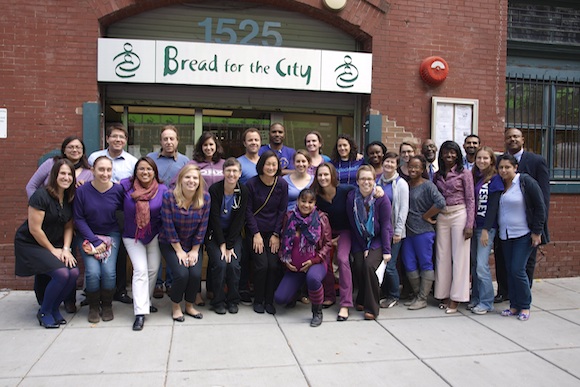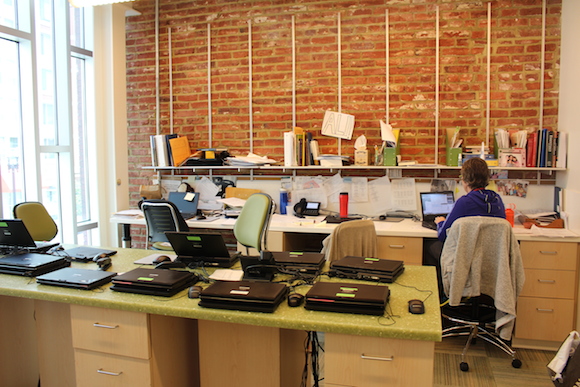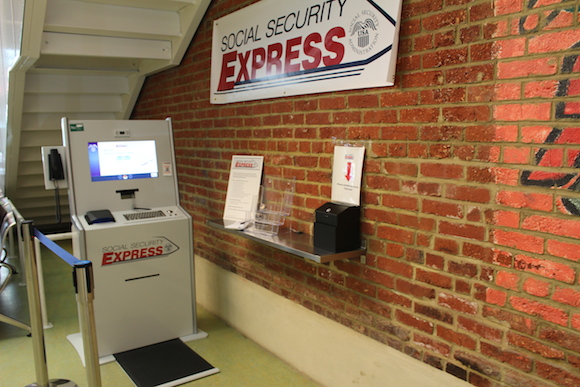Bread for the City’s social workers are using technology to cut down on red tape to better serve impoverished DC residents.
At Bread for the City, a routine task delegated to a student intern more than a decade ago has now sparked a national movement.
Stacey Johnson was instructed to update a listing of the resources the Shaw nonprofit could direct to impoverished D.C. residents.
The directory in 2002 was unwieldy and unreliable: each entry was spread out in different Word documents, and Johnson had to verify them all by making phone calls.
“You get a different answer with each different person that you could talk to,” says Johnson. “It was really inefficient.”
So during her winter break, she created an Access database, which simplified the process of inputting information and made it easier to pull out details for clients.
Many years later Johnson, who has stayed on with Bread for the City as a social worker, realized there could be an even better fix.
Because the nonprofit has its hands in so many different service areas – from health care to legal assistance and hunger relief – its social workers are well positioned to spot larger inefficiencies in need of repair. Consequently, the nonprofit is becoming a breeding ground of sorts for civic hackers, those next-generation activists who are turning to technology to solve community ills throughout the DC community.
Open Information
During his four years at Bread for the City, Greg Bloom launched the “Save our Safety Net” campaign to protest welfare reform via online petition — before Change.org made a petition easy to do.
He also publicized the
DC Food Finder map, organized a computer literacy workshop called the
DiscoTech and
led the charge to connect Bread for the City to a city-owned broadband Internet infrastructure called DC-CAN.
Soon enough, he and Johnson began talking shop about the directory.
“I was observing that other organizations were coming to us and asking for that data,” says Bloom. “It was gathered in a lot of different silos and none of them were perfected or up to date.”
Johnson envisioned a shared, citywide catalogue in which each organization could modify its own information as needed.
“One shared one is better than all of us trying to maintain our own,” she said.
Bloom brought other community groups, along with the District’s Department of Human Services and the Office of the Deputy Mayor for Health and Human Services
, to the table. They launched Open 211 — a project to make the disparate databases of local community resources speak the same language. Bloom now works full time on the project, which has spread throughout the country, from San Francisco to Miami and beyond.
The new movement, called “Open Referral,” has even formed partnerships with civic technology groups in Canada and Spain.
Speaking over the phone from San Francisco, Bloom explained why he thought Bread for the City was a natural incubator for grassroots innovation.
The organization served 33,000 D.C. residents last year, addressing their most pressing needs with medical clinics, legal assistance, job training, a food pantry and a number of other programs.
“The staff and the volunteers there think about the interconnectedness of things,” says Bloom. They “start asking questions that will lead you to grapple with systemic dysfunction.”
Bread for the City’s 101 employees, which includes a six-person technology team, have to do more with less. “Need is the mother of all invention,” Johnson says.
 Reaching out
Reaching out
To see some technical hacks come to light, Bread for the City has regularly enlisted the help of outside groups.
Take the subsidized housing applications that Bread for the City workers help fill out. They’re a headache, in more ways than one.
Every day, Johnson has to scour the newspaper to look up new openings at apartment buildings that accept Section 8 vouchers. And every few weeks, she calls them directly.
When she finds a new available apartment, she sends out the details via a Google Group listserv and group texts to more than 900 cell phones.
In an attempt to make the process less clunky, Bread for the City teamed up with an organization that teaches civic activists to code, in order to create an easier alert system.
Last summer, three Code for Progress fellows worked on a texting app that would automatically blast out texts to eligible applicants as soon as a listing opened up.
Among the fellows was Terri Acker, an Anacostia resident who has been a Bread for the City client for decades and now serves on its client advisory board.
Though they weren’t able to finish it in time, the fellows created the shell of a program that Bread for the City might pick up later down the line.
Then, there are the housing applications themselves – an avalanche of paper and PDF forms.
“We were filling out lots and lots and lots of applications by hand,” said Johnson. Each building has its own application. “While they're all different they all ask for the same information,” she said.
In May 2013, Bloom gave Code for D.C., a local group of civic hackers, a mission: to simplify the tortuous low-income housing application process.
Since community organizations are rarely the ones to approach civic hackers with problems to solve, Marcus Louie, a Code for D.C. volunteer, was enthusiastic.
“This was [a] home run,” he said. “It’s kind of helping lay a blueprint for how we might work with other organizations.”
Louie’s team designed an online form that caseworkers can fill out with all the relevant information for each subsidized housing applicant.
The information can then be populated onto a PDF form that corresponds to each building’s individual application form. It currently works for about a dozen buildings, he said.
The app is currently being tested, and Bread for the City is exploring partnerships with the U.S. Department of Housing and Urban Development to possibly expand it.
Cutting out red tape
Bread’s extensive client database has also allowed the organization to cut down on other inefficient processes.
For years, food pantries had requested third-party organizations to identify who needed assistance through a referral system – at great cost for the clients, who complained they had to travel to Bread for the City just for a piece of paper, and for Bread for the City, whose staff suspected they were spending a lot of time on referrals instead of working more productively with clients.
Bread for the City ran some reports and found it had given out a total of 1,141 referrals during the first half of 2014.
In April, the nonprofit moved to end the referral system in partnership with the Capital Area Food Bank. After these two large organizations stopped giving out referrals, most of the food pantries in the area dropped the referral requirement.
 Bread For the City's health center
Bread For the City's health centerThe organization has found other ways to minimize administrative hassles for its clients. It operates its own medical portal in which patients can access their health records. In the lobby of Bread for the City’s Shaw center, a Social Security express kiosk allows users to check their benefits and make transactions on the spot.

And Bread for the City is also seeking grants for a telemedicine program that would allow clients to get consultations from doctors remotely.
“Our clients usually have more than one thing going on in their lives,” said spokeswoman Karen Byer. “If there is a barrier we will try to knock it down.”